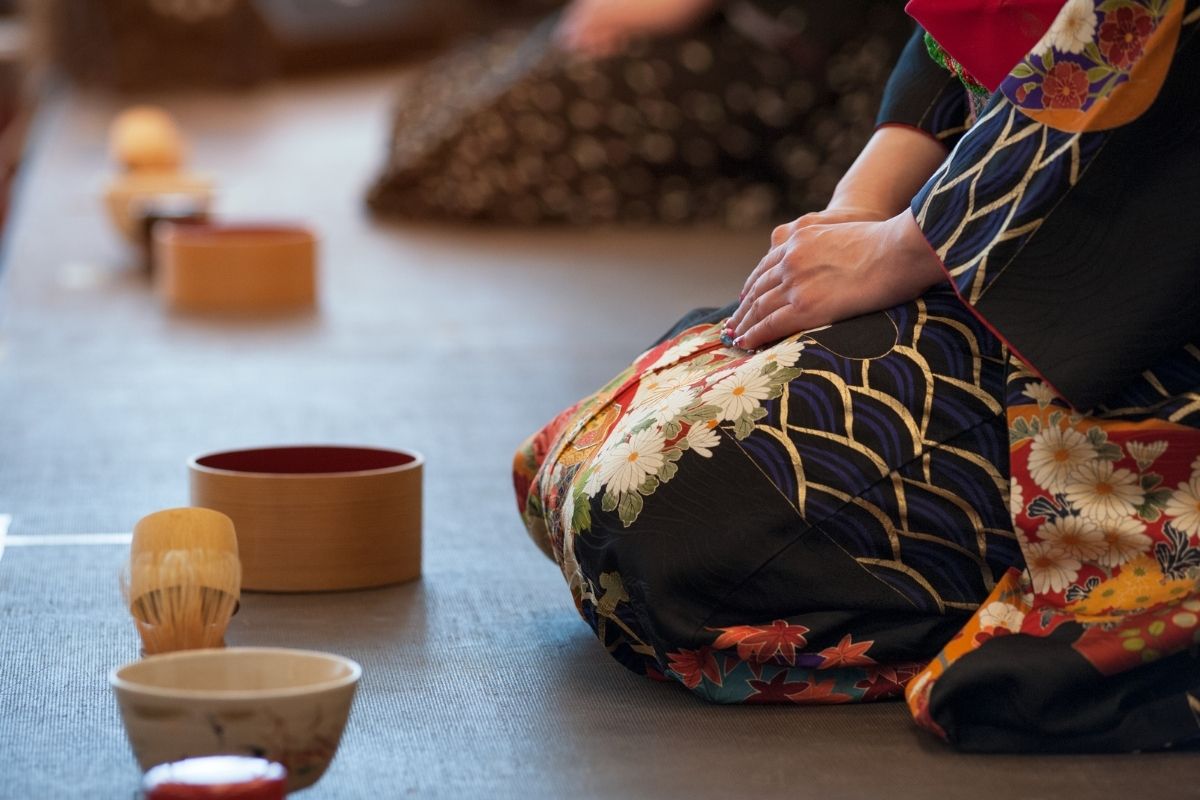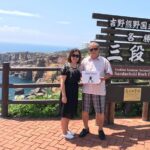Tea Ceremony, also known as Chanoyu or Sado, is a traditional Japanese art that involves the ceremonial preparation and presentation of matcha, a powdered green tea.
The ceremony is a highly ritualized and meditative practice that has been passed down for generations and is still widely practiced today in Japan and other parts of the world.
The origins of the Tea Ceremony can be traced back to the 9th century when tea was first introduced to Japan from China.

Over time, the practice of drinking tea evolved into a highly formalized ritual that emphasized harmony, respect, purity, and tranquility.
Today, the Tea Ceremony is considered a cornerstone of Japanese culture and is often used to welcome guests, celebrate special occasions and promote mindfulness and relaxation.
During the Tea Ceremony, guests are led through a series of precise and deliberate movements, from the preparation of the tea to the cleaning of the utensils.
Each element of the ceremony is carefully choreographed to create a sense of harmony and balance and to foster a deep appreciation for the beauty and simplicity of everyday life. on.
History of Tea Ceremony

The ceremony has a long and rich history that dates back to the 9th century when tea was first brought to Japan from China.
Initially, tea was used as a medicinal drink by Japanese Buddhist monks. However, over time, it became a popular beverage among the aristocracy and eventually spread to the general population.
The tea ceremony as we know it today began to take shape during the 16th century when the tea master Sen no Rikyu refined the practice and elevated it to an art form.
The tea ceremony is deeply rooted in Japanese culture and is often seen as a way to promote harmony, respect, and tranquility. It is a highly choreographed ritual that involves specific movements and gestures, such as the way the tea is prepared and served, the way guests are seated, and the way the tea utensils are handled.
Today, the tea ceremony continues to be an important part of Japanese culture and is often practiced by tea enthusiasts around the world. It is a way to connect with others, appreciate the beauty of nature, and find inner peace.
Types of Tea Ceremony

Tea ceremonies are an integral part of Japanese culture, and there are several types of tea ceremonies that have evolved over the years. Each type of tea ceremony has its unique characteristics and is performed for different occasions and purposes. In this section, we will explore the different types of tea ceremonies.
Chaji
Chaji is the most formal type of tea ceremony and is performed on special occasions, such as weddings or funerals. The ceremony can last up to four hours and involves a full-course meal, as well as the serving of tea. The tea used in chaji is typically high-quality matcha, and the ceremony is performed in a specially designed tea room that can accommodate a small number of guests.
Chakai
Chakai is a less formal type of tea ceremony that is performed for more casual occasions, such as welcoming guests or celebrating the changing of seasons. The ceremony typically lasts around two hours and involves the serving of light refreshments, as well as the serving of tea. The tea used in chakai is typically of a lower quality than that used in chaji, and the ceremony is performed in a less formal setting, such as a garden or a larger tea room.
Chabako
Chabako is a type of tea ceremony that is performed outdoors and is often used as a way to enjoy nature. The ceremony involves the use of a portable tea set, which is carried to a scenic location, such as a park or a mountain. The tea used in chabako is typically of a lower quality than that used in chaji or chakai, and the ceremony is performed in a casual setting, with guests sitting on the ground.
Overall, tea ceremonies are an important part of Japanese culture, and each type of tea ceremony has its unique characteristics and is performed for different occasions and purposes. Whether you are attending a formal chaji or a casual chakai, the experience of drinking tea in a traditional Japanese setting is a memorable one that should not be missed.
The Tea Ceremony Process

The tea ceremony, also known as Chanoyu, is a Japanese cultural activity that involves the ceremonial preparation and presentation of matcha, a powdered green tea. The ceremony is a highly ritualized and choreographed event that requires years of practice to master. The tea ceremony is a way to appreciate the beauty of simplicity and to find peace and tranquility in the moment.
The tea ceremony process typically involves the following steps:
- Purification: Before the ceremony begins, the host will purify the tea utensils and the tea room to create a clean and sacred space.
- Preparation: The host will then prepare the tea by whisking the powdered matcha with hot water in a bowl until it becomes frothy.
- Presentation: The host will present the tea to the guests with a bow, and the guests will admire the tea bowl and its design before taking a sip.
- Drinking: The guests will then take turns drinking the tea, savoring the flavor and texture of the matcha.
- Cleansing: After the tea is finished, the host will clean the utensils and the tea room to restore them to their original state.
The tea ceremony is a highly formalized event that emphasizes harmony, respect, and tranquility. Each movement and action has a specific meaning and purpose, and the ceremony is designed to create a sense of calm and inner peace. The tea ceremony has been practiced for centuries in Japan and is still a popular cultural activity today.
Tea Ceremony Tools and Utensils

Tea ceremony is a highly ritualized practice that requires a specific set of tools and utensils. These items are carefully chosen for their aesthetic and functional qualities, and they play an essential role in the ceremony. Here are some of the most important tools and utensils used in a traditional tea ceremony:
- Chasen (Tea Whisk): The chasen is a bamboo whisk used to mix the powdered tea with hot water. It is made from a single piece of bamboo and has between 80 and 120 thin tines that are split at the end to help create a frothy texture.
- Chawan (Tea Bowl): The chawan is a ceramic bowl used to prepare and serve the tea. It is typically made by hand and has a simple, rustic design that emphasizes the natural beauty of the clay.
- Chashaku (Tea Scoop): The chashaku is a bamboo scoop used to measure the powdered tea. It is usually carved from a single piece of bamboo and has a thin, curved shape that allows it to scoop up just the right amount of tea.
- Kama (Tea Kettle): The kama is a cast iron kettle used to heat the water for the tea. It is typically placed over a charcoal fire and has a simple, elegant design that complements the other tools and utensils.
In addition to these four essential items, there are many other tools and utensils that may be used in a tea ceremony, depending on the specific style and tradition. Some of these include:
| Tool/Utensil | Description |
|---|---|
| Chakin (Tea Cloth) | A white linen or hemp cloth used to wipe the chawan and other utensils during the ceremony. |
| Fukusa (Silk Cloth) | A silk cloth used to handle the hot kettle and other utensils during the ceremony. |
| Hishaku (Bamboo Ladle) | A bamboo ladle used to pour the hot water into the chawan. |
| Kensui (Waste Water Bowl) | A ceramic bowl used to dispose of the waste water from the tea preparation. |
Each of these tools and utensils has a specific purpose and meaning within the tea ceremony. They are carefully chosen and arranged to create a harmonious and aesthetically pleasing environment that enhances the experience of the tea ceremony.
Tea Ceremony Etiquette

Tea ceremony is not just about drinking tea; it’s a cultural experience that involves a set of customs and etiquette. To fully appreciate and participate in a tea ceremony, it’s essential to know the basic rules and manners. Below are some of the most important tea ceremony etiquette practices:
- Arrive on time: Punctuality is highly valued in tea ceremonies. Arriving late is considered disrespectful to the host and other guests.
- Dress appropriately: Dress modestly and avoid wearing strong perfumes or colognes that may overpower the fragrance of the tea.
- Wash your hands: Before entering the tea room, guests are required to cleanse their hands and mouth with water. This ritual symbolizes the purification of the mind and body.
- Enter the tea room: When entering the tea room, guests should bow to the host as a sign of respect.
During the ceremony, guests should follow these etiquette practices:
- Wait for the host: Guests should not start drinking or eating until the host has taken the first sip or bite.
- Handle the tea bowl with care: The tea bowl is a prized possession and should be handled with care. Hold it with both hands and avoid touching the rim.
- Drink the tea: Drink the tea in three sips, making a slurping sound to show appreciation to the host.
- Compliment the host: After drinking the tea, guests should compliment the host on the taste and presentation of the tea.
By following these etiquette practices, guests can fully immerse themselves in the tea ceremony experience and show respect to the host and other guests.
Significance of Tea Ceremony Today

The traditional Japanese tea ceremony, or chanoyu, has been practiced for centuries and has evolved into a cultural art form. Today, it is still widely practiced and revered for its beauty, simplicity, and mindfulness.
The tea ceremony is a way to connect with oneself, others, and nature through the sharing of tea and the appreciation of the present moment.
It has become increasingly popular in recent years as a way to disconnect from the fast-paced, technology-driven world and find inner calm and peace. It is a way to slow down and appreciate the beauty in the simple things in life. Many people have found that practicing tea ceremonies has helped them reduce stress, increase focus, and improve their overall well-being.
Additionally, the tea ceremony has become a way to connect with others and build community. Tea houses and tea ceremonies are often open to the public, and attending one can be a great way to meet new people and learn about Japanese culture. The tea ceremony is also often used as a way to entertain guests and show hospitality.
Overall, the tea ceremony continues to be a significant cultural practice in Japan and around the world. Its emphasis on mindfulness, simplicity, and connection with others and nature make it a valuable tool for personal growth and community building.
The Sum Up

After experiencing the tea ceremony, it’s easy to see why it has been a cherished tradition in Japan for centuries.
The ceremony is not just about drinking tea, but it’s also about creating a peaceful and harmonious atmosphere. The entire process, from the preparation of the tea to the serving of it, is done with great care and attention to detail.




